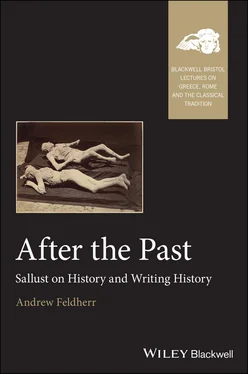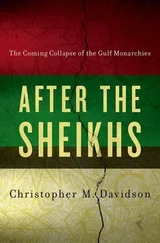If we hear Sallust’s proclamation of the novitas of the Catilinarian conspiracy as an Alexandrian claim to originality, the sudden reimagination of that event as a new subject, nothing could more strongly mark the deaths of the past years as an ending point. It had until just a few years ago been one of the most retold stories of the recent past. Perhaps by stressing its difference from epideictic, history can step outside this tradition by historicizing it and designating its ending. Perhaps the deaths of all of the protagonists of his story, and of all its narrators, look to a world where history can be seen as history, as the shared story of a collective rather than of competing individual perspectives on individuals. On the other hand, if Cato’s was the death of libertas , and if all these further deaths were similarly hypostasized in a way that confuses, as Thucydides (7.77.7) would have it, the state with the men living in it, what other perspective would exist for looking back at Roman history than that of the individual survivor? And what other use would there be for Roman history than as a lesson about fortune, and especially virtus ?
Such a perspective puts the greatest distance between Sallust’s audience and the res gestae populi Romani and stakes it to a fundamental difference between remembering virtutes and remembering events. One ideal of Roman history, allegedly practiced by Cato and occasionally imitated by Sallust, records only deeds and not the men who performed them. 16And the distinction between obscuring individual men’s deaths within the history of the res publica and imagining that res publica itself as able to die with, even like, a Cato, whose own virtus survives his libertas , helps explain the divergent patterns of time within Sallust’s work. The most successful Roman statesmen could look forward not just to being remembered in history but to defining Roman time, to becoming part of the fasti whether as a triumphator or a consul. Yet, as Sallust will point out in the Jugurtha , winning the sort of honores that put you on the map of Roman time does not provide a sufficient index of virtus . He expresses his scorn for those who believe that “praetorships and consulates are bright and magnifying in and of themselves, and not measured according to the virtus of those who held them.” 17 Virtus and the res publica are not only moving on different trajectories, the one getting bigger as the other diminishes, but they operate on their own calendars. 18As opposed to perceiving the memorials of Roman history as transparent to virtus and predicating it of all those whose names it records, Sallust proposes a conception of virtus that cannot be read simply from monuments, but which, conversely, can live on after the res publica .
With the aid of Brutus’ lost works, I have completed the first two thirds of my argument. I used Brutus’ activity as historical epitomizer to connect the reader’s alternative sense of distance from and continuity with the narrated past to a perception, due not just to the civil wars but already to the impact of Sulla, that the course of Roman history had been interrupted, the mechanisms of memory altered, and perceptions of time challenged. Next, the comparison between Sallust’s history and the epideictic literature describing the life and death of Cato pointed to a new break from the past, resulting from the recent deaths of the major figures of Sallust’s narrative. This new separation now places the text even more strikingly at the point separating the past it recounts, the present in which it is written, and the future in which it will be read. And these competing perceptions of the text’s position in time correlate the question of the persistence of the res publica it describes not only with the shift from reality to representation but with the alternative of a story written about, by, and for individuals who live independently from and perhaps after that res publica . In this final section, I want to zero in on that fundamental tool Sallust uses to represent such a past, language, to demonstrate how Sallust creates an awareness of words themselves as responsive to different views of time. Thereby, the act of interpreting his text generates and responds to the readers’ consciousness of their position within history.
The impression of a misalignment between the aims of praising and blaming individuals and narrating res gestas populi Romani results from the challenge of matching the quality of virtus to the record of public action. As actions and honors no longer in themselves reveal the character of men, res gestae must give way to panegyric, and both the reader and the potential actor will need to find an alternative to political success to create a memory of themselves. This notion of a virtus that stands apart from achievements becomes so pervasive in the literature of the period as to appear as a commonplace, but it is no less important for that. Virtus above all transcends temporal limits. Thus, after the death of his friend Scipio, Cicero’s Laelius will say, “he lives for me because I loved the virtus of the man, which has not been snuffed out” ( mihi quidem Scipio, quamquam est subito ereptus, vivit tamen semperque vivet; virtutem enim amavi illius viri, quae extincta non est , Cic. Amic . 102). Virtus also follows the exile across spatial boundaries, as is shown by a sententia preserved by Seneca from a late Republican treatise de Virtute ( On Virtue ) whose author considered it “sufficient that it is permitted for those going into exile to bring their own virtutes with them” ( quod licet in exilium euntibus uirtutes suas secum ferre , Sen. Helv . 8.1).
The author of this recognition that virtutes come in individual travel sizes, independent of the dimensions of space and time that Rome’s political imperium strives to measure and control, was Brutus himself. And this third lost work, de Virtute , represents the last of the three discourses against which I want to read the Catiline , philosophy. For, if the formal aspect of Sallust’s prefaces suggests an engagement with epideictic oratory, the substance of these openings comes from philosophy. And the connection between the two alternatives to history will be obvious. The ethical philosophy Sallust presents in his openings will be true for all people in all times. Also, it proposes a system of value, and a way of describing action, that liberates the individual from the judgment of the state, from the exchange of praise and blame that, far from measuring worth from a position outside history, has been made subject to the historical transformations of the res publica . Of course, Sallust was not the only writer to import the language of philosophy into history, to challenge Aristotle’s claim that history was inevitably less philosophical than poetry because of its intrinsic connection with the specific rather than the general ( Poet . 9=1451b). But here too, just because the incorporation of philosophy and history was possible, does not mean it was inevitable or unproblematic. 19In the remainder of this chapter, I will take the approach that Sallust does not so much take over a tradition of generic blending but draws attention to the relationship between the aims of history and philosophy, and in doing so he evokes that contrast with which we began between a point of view of the Roman past located outside of it and of the temporal continuities that continue to control the audience’s understanding of the text and draw them back to the position of those spectators of Catiline’s corpse.
Читать дальше












